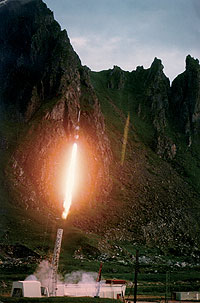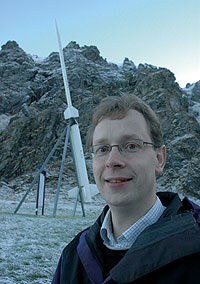OSLO, Norway, November 14, 2008 – Some time between the end of November and the beginning of December, Jøran Moen, professor at the Institute of Physics at the University of Oslo, plans to fire a rocket from New Aalesund on the Svalbard archipelago with the hope of solving fundamental physics problems in the atmosphere.
Through this experiment, Moen hopes to gain a better understanding of the connection between the northern lights and disturbances to navigation systems and radio signals.
The Rocket, seen here, will be launched between November 28 and December 7. Photos courtesy ofYngve Vogt.
Because of the curvature of Earth, the airplanes flying the polar routes have to use high-frequency radio communication. The radio signals are sent via the ionosphere, which lies between 80 and 500 km above the landscape. This consists of a layer of gas with electronic particles that reflect the signals back to Earth. When the northern lights are active, they create so much turbulence in the electronic clouds that the radio signals are cut off. In addition, it is not unusual for solar storms to cause inaccuracies of up to100 meters on the GPS.
Professor Moen is planning to use the registrations from the rocket to gain a better understanding of the connection between the northern lights and the disturbances to navigation systems and radio signals.
“This knowledge is essential for developing warning systems that can deal with these problems,” explained Moen.
The rocket is nine meters long and will be fired at a suitable time between November 28 and December 7. The flying time is calculated to last only ten minutes, and the rocket will cut through the northern lights at an altitude of 350 km, and then plunge into the Barents Sea.
The rocket is equipped to measure the electric fields and waves of the northern lights, particles of low and high energy in these lights, and fine structures in the electronic clouds. Until now it has only been possible to examine the dissolution of electronic structures of a few hundred meters of a northern light. The rocket instruments from the University of Oslo can concentrate on structures down to a few meters.
“If we succeed in flying through the northern lights, we will set a world record in measurements of highly dissolved electronic precipitation in these lights,” said Moen. 
Moen is planning to use the registrations from the rocket to gain a better understanding of the connection between the northern lights and disturbances to navigation systems and radio signals.
The rocket has a predetermined course, which means Moen has to forecast the precise moment when the northern lights will cover the rocket track. To hit the target he is depending on the assistance of experts on northern lights in New Aalesund and Longyearbyen to interpret the data from the Eiscat radar in Svalbard. He will also be helped by signals from a radar system in the vicinity of Helsinki, Finland. This can record echoes from high-frequency radio signals over Svalbard. The intensity of the echo signals will determine the extent of the northern lights activity.
Moen will also interpret the data from a NASA satellite that measures solar winds on their way from the Sun to Earth. These data can give the operators an extra hour to consider pending northern lights activity.
“We are planning to fire the rocket when the northern lights are stabilizing over the course for the rocket. But the dynamics of the northern lights are so spontaneous that we can’t guarantee, one hundred per cent, that the rocket will target the northern lights accurately.”
In order to secure an optimal time for launching the rocket, the airspace over the North Atlantic between Iceland, Greenland, Norway and Svalbard will be closed for four hours every day for one and a half weeks.
The rocket is filled with advanced instruments. In its basement at the Institute of Physics, the University of Oslo has developed a new instrument for measuring the fine structures of electronic clouds. The European space organization ESA is interested in using this instrument in satellites for forecasting space weather.
“The importance of better forecasts of space weather will increase with the escalating offshore activities in the Barents Sea. Offshore is dependent on stable radio and satellite connections and precise navigation,” explained Moen.
For more information, visit: www.uio.no